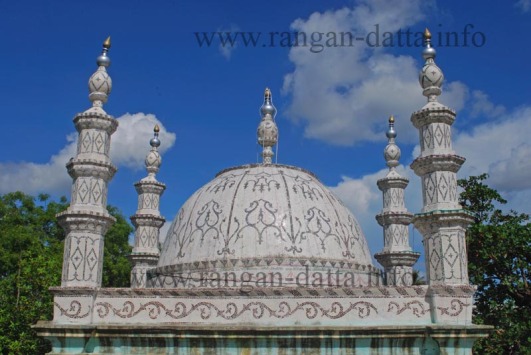| Mazar Sharif Ala Hazrat |
Early life of Ahmed Raza Khan :
Religious studied and his Books:
In the year 1856 Ahmed Raza Khan was born in Jasoli on 14th June at Bareli Sharif, united India. Mohammad was his birth name however Ahmed Raza called by his grandfather and Amman Miyan called by his mother. He became popular with the name Mohammad which was given by his father. But before signing his name in any correspondence he used the title Abdul Mustafa(slave of Mustafa). His father Naqi Ali Khan was a great scholar, under his supervision Ahmed Raza Khan studied the Islamic Science and he completed a traditional course Dars-i-Nizam. Ahmed Raza Khan went on the Hajj in the year 1878 with his father.
Barelvi movement of South Asia founded by a Hanafi Sunni, named Ala Hazrat. There was so many books written on different topic by Ahmed Raza Khan. He wrote the books on Religion, Law, Philosophy as well as Science. As a prolific writer Ahmed Raza Khan producing more or less 1000 words in his whole life.
The Qur'an translated by Ahmed Raza Khan in Urdu, which was first published in the year 1912 as the title Kanz-ul-Imam fi Tarjuma al-Qur'an. The original manuscript's of the translated copy is preserved in the library of Idara Tahqiqat-i-Imam Ahmed Raza(Karachi). Later the English version of Kanzul Imam has also been published. On the collection and compilation of Hadiths, he also wrote so many books.
Mahatma Gandhi a non-Muslim leader, under this leader Ahmed Raza Khan and his movement with so many other Muslim leaders of the area compete the Indian independence movement with there leadership.
Ahmed Raza on his Child Hood:
According to Sayyid ayub Ali when Ala Hazrat was a young child, Maulvi Shahib teach him in his house. At once during teaching Maulvi Shahib was telling Ala Hazrat again and again to say a same word, but Ala Hazrat can't pronounce it. The Maulvi Shahib was pronouncing the word with a zabr and Ala Hazrat was pronouncing zer to the same word. This was happened several time, in the presence of his grandfather Maulana Raza Ali Khan. This time his grandfather told him to check it from the Holy Qur'an. While going through the Holy Qur'an, it was found that the printer make the printing mistake zabr instead of a zer. Then it was found that Ala Hazrat was actually perfect with his pronunciation.
Mahatma Gandhi a non-Muslim leader, under this leader Ahmed Raza Khan and his movement with so many other Muslim leaders of the area compete the Indian independence movement with there leadership.
Ahmed Raza on his Child Hood:
According to Sayyid ayub Ali when Ala Hazrat was a young child, Maulvi Shahib teach him in his house. At once during teaching Maulvi Shahib was telling Ala Hazrat again and again to say a same word, but Ala Hazrat can't pronounce it. The Maulvi Shahib was pronouncing the word with a zabr and Ala Hazrat was pronouncing zer to the same word. This was happened several time, in the presence of his grandfather Maulana Raza Ali Khan. This time his grandfather told him to check it from the Holy Qur'an. While going through the Holy Qur'an, it was found that the printer make the printing mistake zabr instead of a zer. Then it was found that Ala Hazrat was actually perfect with his pronunciation.




